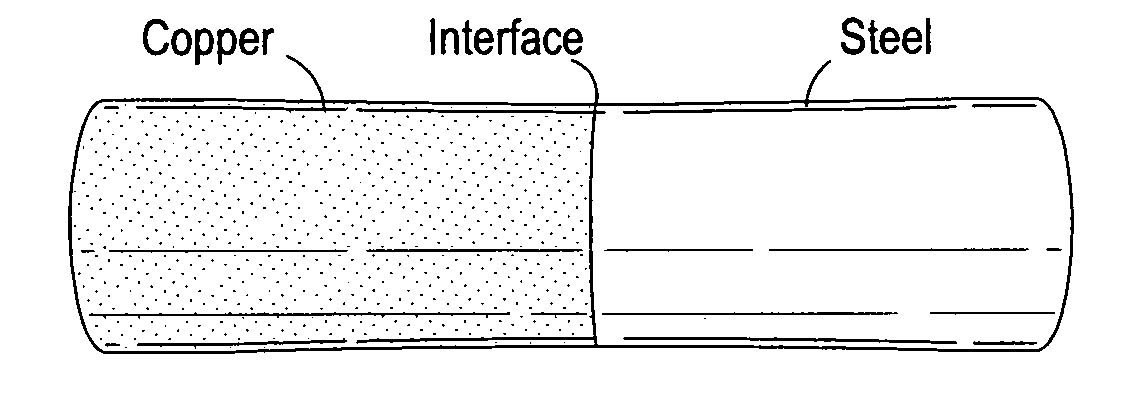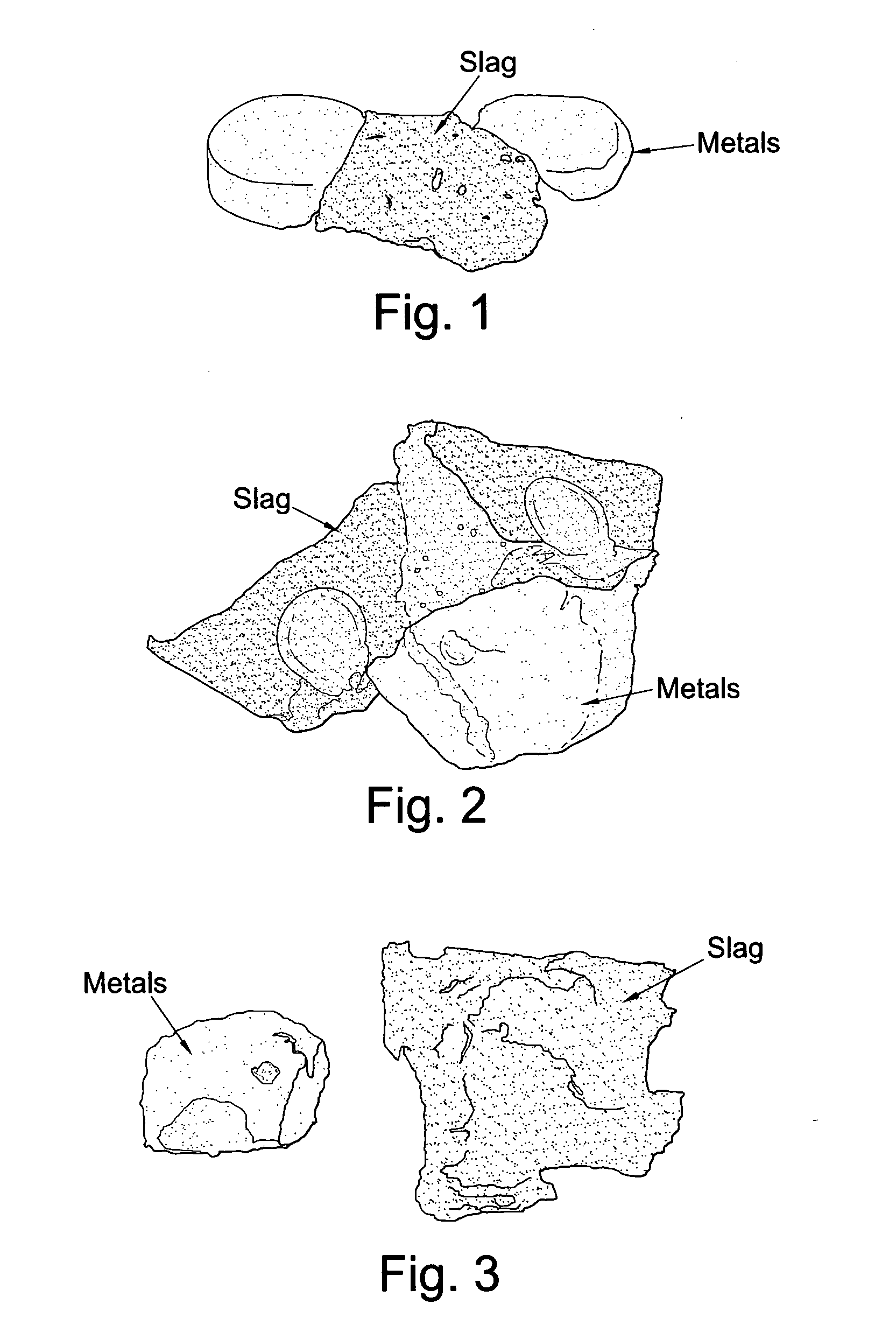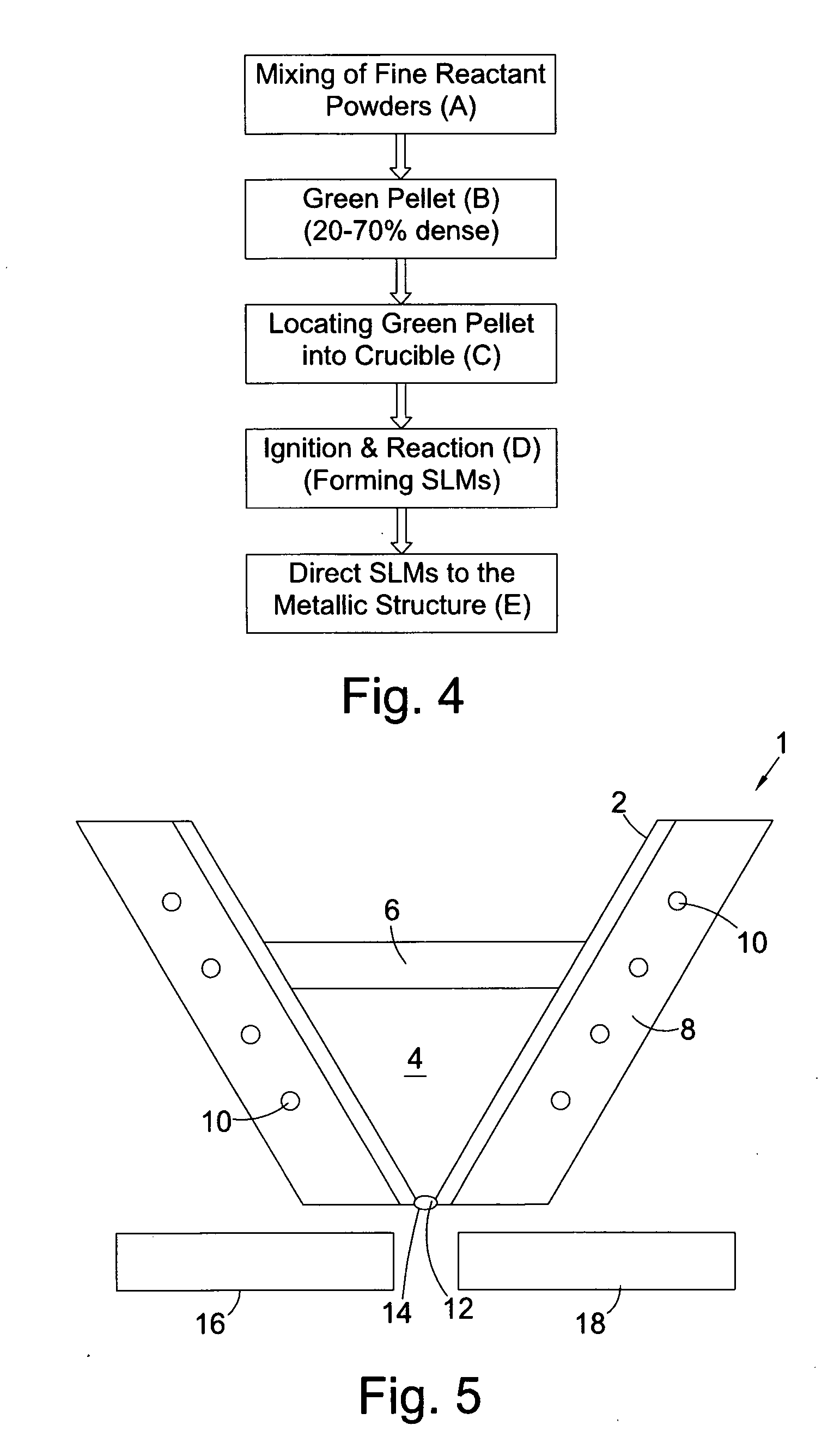Exothermic mixture
- Summary
- Abstract
- Description
- Claims
- Application Information
AI Technical Summary
Benefits of technology
Problems solved by technology
Method used
Image
Examples
example 1
[0095]Superheated liquid Cu can be generated by the following reaction mixture (mass): 40.1% CuO, 3.4% Al, 50.4% Cu, and 6.1% CaSi2. The molar ratio of to aluminium to calcium silicide in this mixture is 2:1. Upon thoroughly mixing of the reactant powders, about 5 g of the mixture was uniaxially pressed into a cylindrical pellet with a relative density of 57% (in comparison with the theoretical density of the mixture). then ignited in air using an oxygen-propane torch. This combustion synthesis reaction had an adiabatic temperature of 2737K. The slag generated had a composition of CaAl2Si2O8 (anorthite). After reaction, the slag was totally separated out from the Cu metal, as shown in FIG. 1. It was also found that the slag was amorphous as shown in FIG. 1 and confirmed by the X-ray Diffraction (XRD). Reaction mixtures with similar compositions and different combustion temperatures can be readily formulated by those familiar to the Combustion Synthesis technique.
example 2
[0096]Cu—Ni alloys (e.g., Cu-10Ni and Cu-30Ni) are widely used in marine and other corrosive environments. Superheated Cu—Ni liquid alloys generated by the current invention can be used to join or repair this kind of structures. The following reaction mixture (mass %) can generate superheated Cu-30Ni liquid: 44.7% CuO, 3.8% Al, 20.7% Cu, 24.1% Ni, and 6.8% CaSi2. The molar ratio of aluminium to calcium silicide in this mixture is 2:1. Upon thoroughly mixing of the reactant powders, about 20 g of the mixture was loosely packed into a cylindrical graphite mould, then ignited in air using a MPS torch. This combustion synthesis reaction had an adiabatic temperature of 2810K. The slag generated had a composition of CaAl2Si2O8 (anorthite). After reaction, slag was totally separated out from the Cu—Ni alloy, similar to the morphology shown in FIG. 1 and it was also found that the slag was in amorphous state. Reaction mixtures with similar compositions and different combustion temperatures ...
example 3
[0097]The Cu—Ni—Sn spinodal alloys (e.g., Cu-15Ni-8Sn and Cu-9Ni-6Sn) are robust materials for bearings. Superheated spinodal liquid alloys generated by the current invention can be used to join or repair this kind of structures. The following reaction mixture (mass %) can generate superheated Cu-15Ni-8Sn liquid: 40% CuO, 3.4% Al, 31.5% Cu, 12.4% Ni, 6.6% Sn, and 6.1% CaSi2. The molar ratio of to aluminium to calcium silicide in this mixture is 2:1. After thoroughly mixing of the reactant powders, about 5 g was uniaxially pressed into a cylindrical pellet with a relative density of 57%, then ignited in air using an oxygen-propane torch. This combustion synthesis reaction had an adiabatic temperature of 2725K. The slag generated had a composition of CaAl2Si2O8 (anorthite). After reaction, slag was totally separated out from the Cu—Ni—Sn alloy, similar to the morphology shown in FIG. 1 and it was also found that the slag was in amorphous and confirmed by the X-ray Diffraction (XRD). R...
PUM
| Property | Measurement | Unit |
|---|---|---|
| Fraction | aaaaa | aaaaa |
| Fraction | aaaaa | aaaaa |
| Fraction | aaaaa | aaaaa |
Abstract
Description
Claims
Application Information
 Login to View More
Login to View More - R&D
- Intellectual Property
- Life Sciences
- Materials
- Tech Scout
- Unparalleled Data Quality
- Higher Quality Content
- 60% Fewer Hallucinations
Browse by: Latest US Patents, China's latest patents, Technical Efficacy Thesaurus, Application Domain, Technology Topic, Popular Technical Reports.
© 2025 PatSnap. All rights reserved.Legal|Privacy policy|Modern Slavery Act Transparency Statement|Sitemap|About US| Contact US: help@patsnap.com



